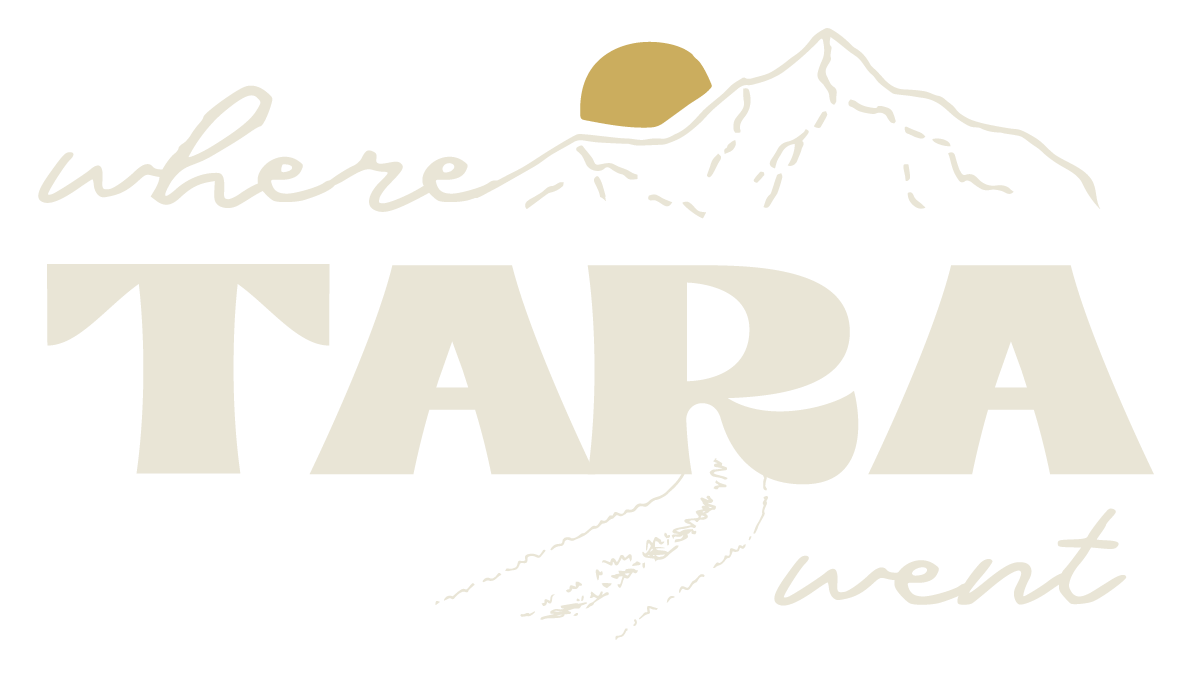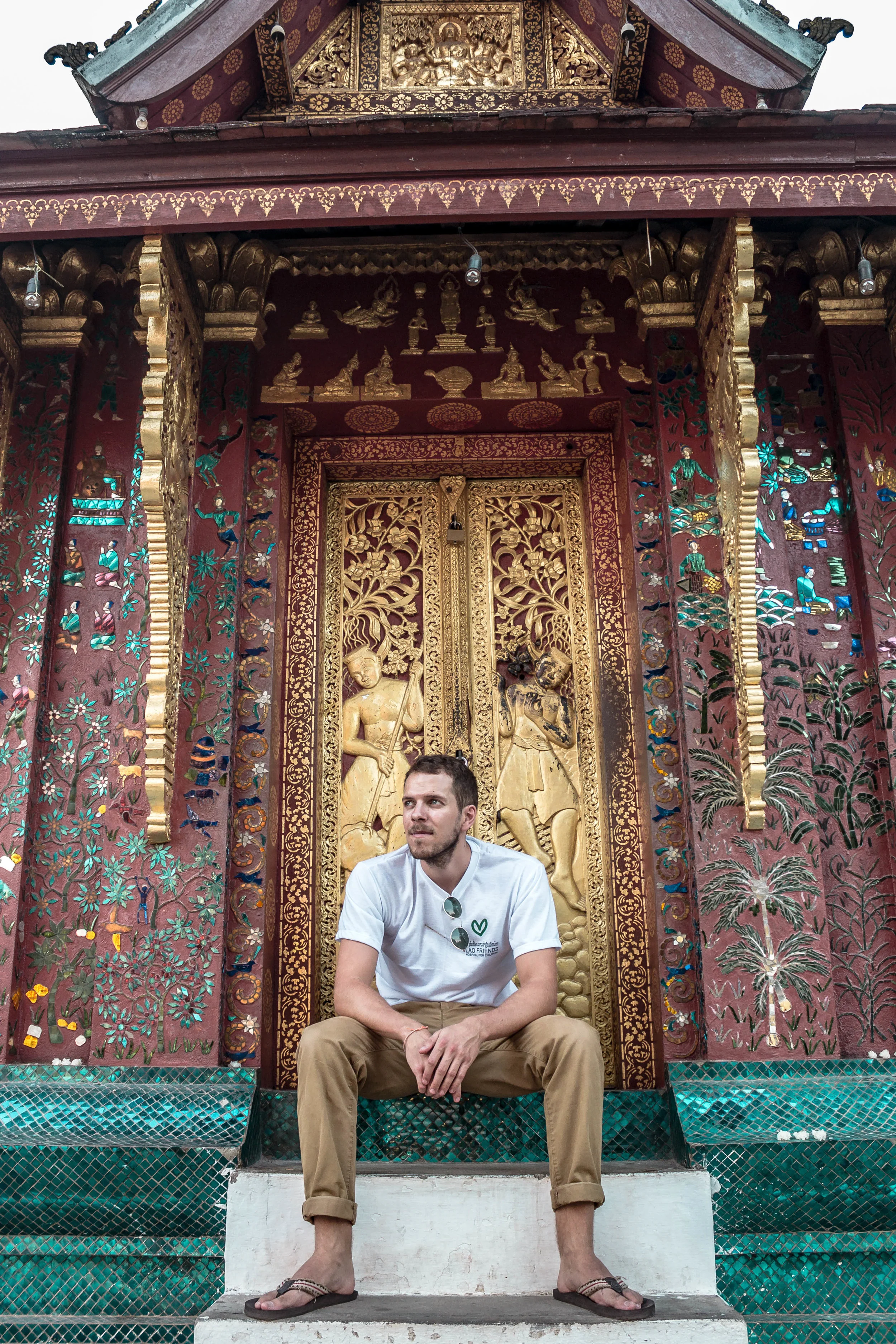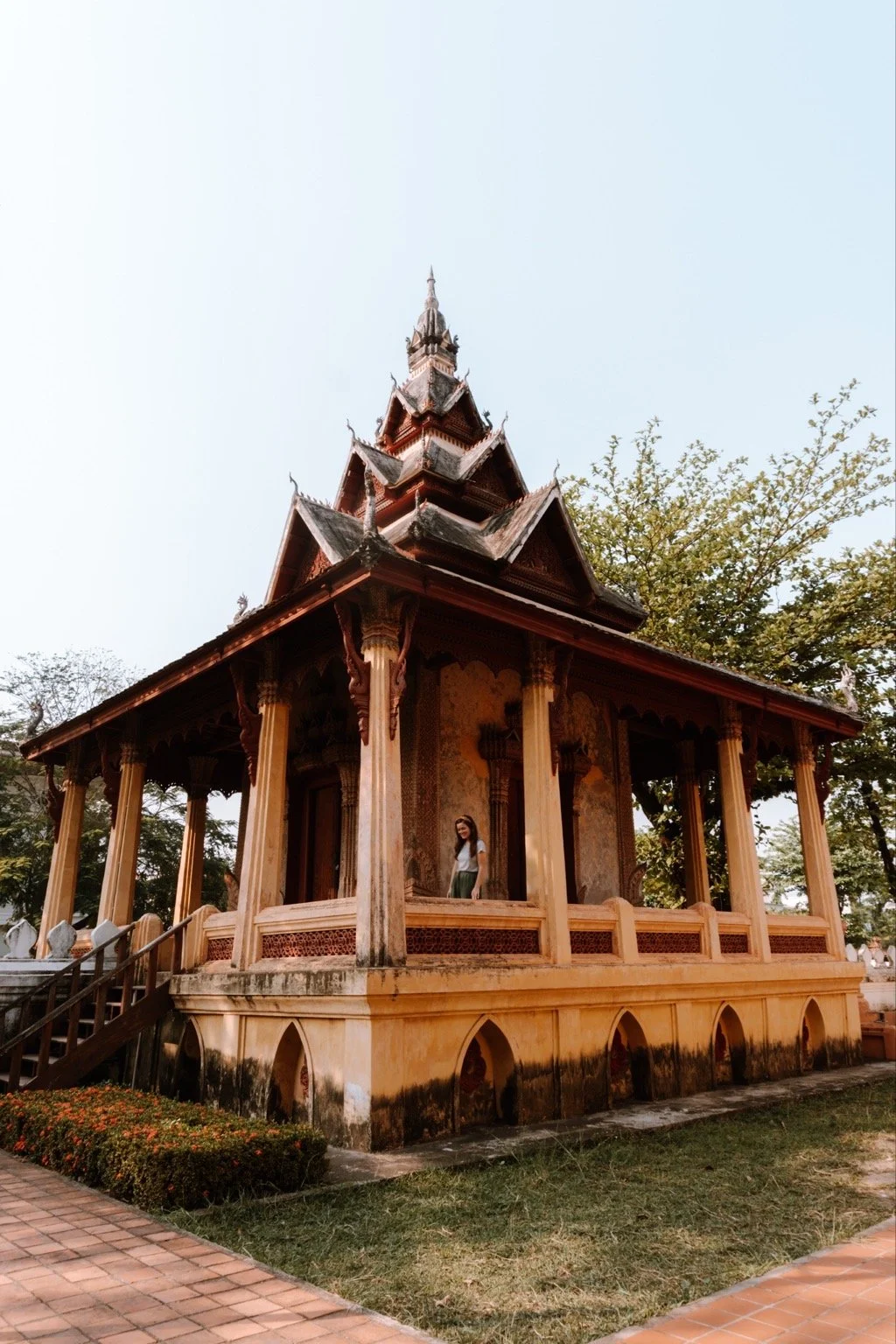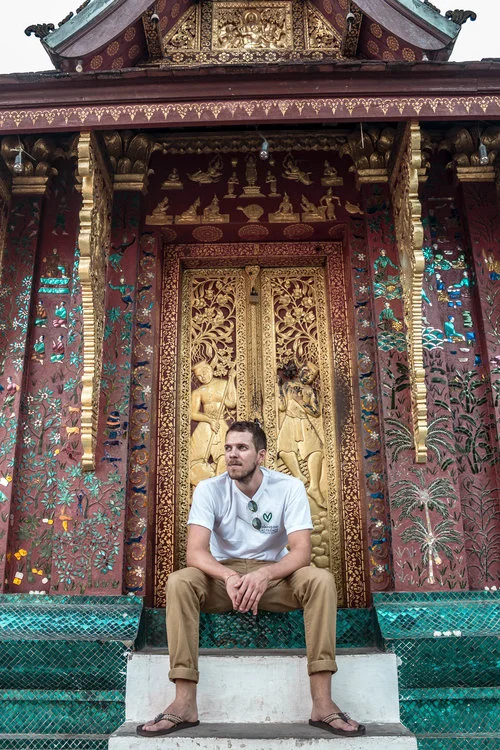what to expect with Orange Robe Tours in Luang Prabang
In Luang Prabang, there are more social enterprises, non-profits, and giveback-businesses than you might believe for such a small town, and that number only seems to be growing. Cafés like Saffron, textile shops like Ock Pop Tok, and tours like Orange Robe Tours all add to the Luang Prabang community.
I wanted to write, in depth, about what Luke {and I} were doing in Laos, and what we continue to do from afar. I think it’s a concept that is sometimes hard for people who haven’t been to Laos to understand because there is a major cultural gap and it seems tricky for people wrap their heads around the need that exists there.
WHY we went to LAOS?
why we went to Laos ↴
There are issues all over the world. Every country has its own set of problems or needs, so, why did we come to Laos?
Simply put: for us, it’s always been Laos.
When our travel {and general life} plans changed drastically in July, we had to decide whether we were going to try to continue to do life together and where we would go to do that. For me, New Zealand feels closest to home and that’s no secret. For Luke, England is both his literal place of birth and the country he identifies as his home. But, given everything that had happened, we had a massive paradigm shift. Life was put into perspective, as cliche as that sounds. Life is really short and waiting until you’re ready to do the big scary thing you’ve always wanted to do insures it never happens.
I had the freedom stepping into freelancing to go anywhere with a semi-affordable cost of living and internet. Luke had the vision to start a social enterprise that he’d been carrying in his heart since 2015. And so, without much discussion or thought, we realized that Laos was where we had met, where we had worked, where we had become friends, and it would be the place we’d go to attempt our big scary things.
the cultrual preservation/tourism conundrum ↴
Laos is almost always the country that gets skipped over by backpackers and travelers in Southeast Asia making their way through “the Big Four” {Cambodia, Vietnam, Thailand, and Laos}. However, with former President Barack Obama’s visit in 2016 and the late famed chef and travel writer Anthony Bourdain’s promotion of the underrated destination on his show, Parts Unknown, Laos is slowly but surely seeing more tourists make their way to the little landlocked country. While not as “on the radar” as Thailand or much-loved Vietnam, there is much to love about Laos, which I’ve written about on multiple platforms.
This slow gain in tourist attention comes as a much needed economical boost while simultaneously creating a cultural worry.
In Luang Prabang, people are clinging onto their culture to protect it if they can. It’s that “clinging on to remain trapped in another time” that is its beauty and what brings about its biggest battle. When travelers learn about places where alms giving is still an honoured tradition every morning and you can hear chanting from the temples every evening…they flock to it {that’s essentially why I went to Myanmar in 2017….because I heard it wasn’t yet swamped with people}. And that’s where the trouble starts.
We’ve already seen tak bat turn into a frenzy for tourists. I’ve witnessed a visitor physically stop the line of monks and novices so that he could get a picture, which is entirely disrespectful not to mention interrupting a religious ceremony. Seeing what main street alms has become truly hurts my heart. It also reaffirms for me how important cultural preservation is while creating opportunity for locals to make an income from the tourism industry.
briding the gap ↴
Many boys, as young as eight or nine years old, leave their families in rural Laos to join the temple in Luang Prabang. It is believed by Buddhist families that this earns the family merit for their next life. For families that are without means, it allows the sons of the family an opportunity to secure themselves shelter, food, and an education {novices attend Monk School where they learn everything from the dharma to chemistry}. Since Luang Prabang is a city by Laotian standards, many rural families send their sons there for temple service rather so that they may find bigger and better opportunities.
By the time a novice is 18, they must make the decision to either continue life in the temple and become an ordained monk, or leave the temple and attempt to reintegrate into laymen life. Leaving means finding a job without previous work experience, applying to University without much guidance or any resources, or returning to their rural villages where opportunities for them to utilize the education they spent a decade acquiring are extremely limited.
We’ve had friends leave the temple and start film production companies {shoutout to Somchit who made the IndieGoGo campaign video}. We’ve had friends leave the temple and study in China, Thailand, Vientiane {the capital of Laos}, Switzerland, America, and Canada. Some have found jobs in hotels, resorts, or restaurants. But there are many, many, many that want to pursue a higher education or develop professionally, but aren’t sure how to go about it. Many don’t have sponsors to help them afford studying in foreign countries. Those that do often have no guidance for acquiring a visa. There are many who do not have anyone to help them find scholarships or assist them in creating resumes, and most have nothing to put on those resumes anyway. One of our former monk friends explained it as a sort of identity crisis.
“I spent seven years in temple. I had a crisis when I left because I didn’t know who I was without it.”
about Luke ↴
Luke is an incredibly private person. He’d rather be the man behind the curtain than the Wizard of Oz, if you get what I mean? But, to me, it’s important for those who take a tour with ORT to understand how this whole thing came to be and a little about the person who envisioned it all.
I just don’t know anyone who is more tender than Luke. He’s the kind of guy that gave his bicycle to a young kid to ride to school, rather than selling it on an expat Facebook page, a thought which never even occurred to him. When an employee had his motorbike stolen, Luke simply handed over his motorbike keys. The generosity that is within his heart is honestly something I cannot explain adequately. And when I try to give him a pat on the back, he swats it away. Because he doesn’t do things for applause or praise. In fact, he’d rather no one knew about any of it. He does these things because he is good, through and through.
In 2015, when I first met Luke, we were in very different places. We were {and are}, in so many ways, very different people. Still, we found common ground between us— the desire to help people. Luke had volunteered in Zambia, India, and Thailand previous to our meeting as volunteers in Laos. That was the first time he had mentioned how he wanted to make a sustainable impact on the community. I saw in Luke someone who was uninterested in labels and the idea of big city-life. Instead, he liked the peace and perspective that life in Luang Prabang brought.
In 2016, we were both back in Laos, working for a philanthropic organization completely by happenstance. Luke became a friend during that time. Working beside and living next door to someone will do that. There were many dinners where we’d talk about what we wanted our individual futures to looks like. Luke’s always included his idea of bridging the gap for those leaving the temple by providing an income, training, professional development, and ultimately support through tours that donated portions of the profits to temples raising funds for restoration and local charities like our friend, Monk Obee’s “Keep Helping Each Other” project. He also talked about how important it was to him to help Luang Prabang maintain its magic despite the growing tourist population. The tours he wanted to offer would teach tourists about Theravada Buddhism as practiced in Laos from the ones who know best— former novices and monks.
Cut to now. It’s a living, breathing social enterprise.
AND one of HIGHEST RATED THINGs TO DO IN Luang Prabang according to Tripadvisor.
how Orange Robe Tours gives back ↴
Orange Robe Tours currently makes monthly donations to the temples involved in our tours, which go directly towards temple restorations and maintenance. The tour schedule is created alongside the temples. This, along with the group size being capped to 6 people, eliminates overcrowding at temples.
ORT has two tour guides, both former novices. Each tour guide earns a fair living wage and has a flexible schedule that allows them to attend the local university. This way, they never have to chose between making a living and acquiring a higher education.
Orange Robe Tours works to preserve the authentic Buddhist culture that exists in Luang Prabang and aligns itself with UNESCO’s mission and values.
what to expect on a tour with Orange Robe Tours ↴
ORT offers short, 1-hour tours in the morning. Afternoon tours will be rolling out starting this May!
Cultural temple tours | After meeting at the ORT office, a tour guide will walk you along the Mekong to the temple. This takes approximately 2 minutes. Once you arrive, you’ll be guided around the temple and given information about temple etiquette, architecture of the temple, folklore associated with the temple, and daily temple life.
Guided Meditation Experiences | The 1-hour Guided Meditation Experiences help tourists understand the important of meditation in Theravada Buddhism. You’ll be guided through sitting meditation, walking meditation, and given the same tips for meditation that young novices new to the temple are shown.
I would never promote a business, brand, or tour I didn’t believe in. However, I understand you may find me a bit biased on this one. So, get a second opinion and read the Tripadvisor reviews for Orange Robe Tours here!
Orange Robe Tours handover ↴
No longer in Laos, Luke is doing his part as Owner and Founder remotely. This has allowed one of our tour guides to receive a promotion and increased responsibilities. It also means he has received further professional development in managerial and administrative tasks. Luke will be returning to Orange Robe Tours regularly and continues to communicate daily with the staff. This has always been in the works— hiring a local manager, putting the business further into the hands of the community.
What’s important to understand about sustainable businesses, is that they shouldn’t be taking jobs away from the local community. In other words, Luke has handed over a majority of his desk duties, because they are a tasks that a local can be earning a wage to complete. What Luke does behind the scenes doesn’t require his constant presence and he would never want to take away a job opportunity from a person in Laos more than capable of doing it themselves. That is what a major part of what makes a business model sustainable— whether it can continue on in the long-term with the support and skills of local people.



































